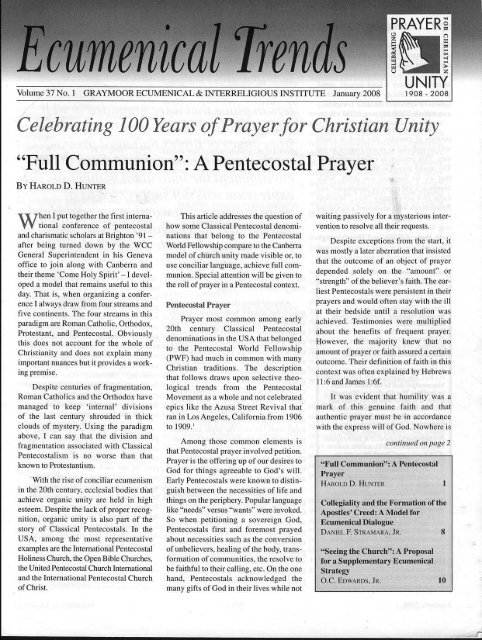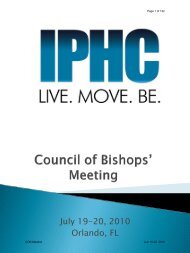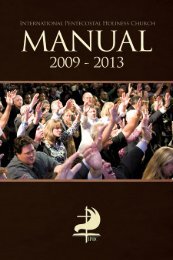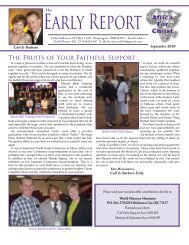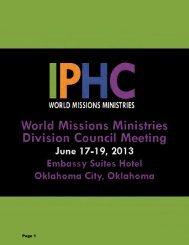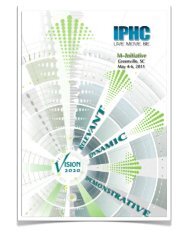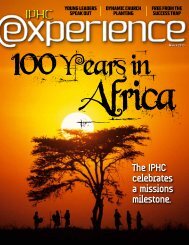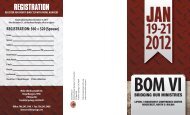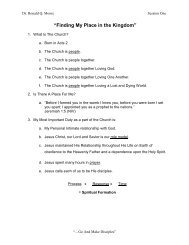"Full Communion": A Pentecostal Prayer - International Pentecostal ...
"Full Communion": A Pentecostal Prayer - International Pentecostal ...
"Full Communion": A Pentecostal Prayer - International Pentecostal ...
Create successful ePaper yourself
Turn your PDF publications into a flip-book with our unique Google optimized e-Paper software.
Ecumenical Trends<br />
PRAYER'<br />
,` z<br />
wv<br />
z<br />
UNITY<br />
Volume 37 No. 1 GRAYMOOR ECUMENICAL & INTERRELIGIOUS INSTITUTE January 2008 1908 - 2008<br />
Celebrating 100 Years of <strong>Prayer</strong> for Christian Unity<br />
"<strong>Full</strong> Communion": A <strong>Pentecostal</strong> <strong>Prayer</strong><br />
BY HAROLD D. HUNTER<br />
hen I put together the first interna-<br />
conference of pentecostal<br />
Wtional<br />
and charismatic scholars at Brighton '91 -<br />
after being turned down by the WCC<br />
General Superintendent in his Geneva<br />
office to join along with Canberra and<br />
their theme `Come Holy Spirit' — I developed<br />
a model that remains useful to this<br />
day. That is, when organizing a conference<br />
I always draw from four streams and<br />
five continents. The four streams in this<br />
paradigm are Roman Catholic, Orthodox,<br />
Protestant, and <strong>Pentecostal</strong>. Obviously<br />
this does not account for the whole of<br />
Christianity and does not explain many<br />
important nuances but it provides a working<br />
premise.<br />
Despite centuries of fragmentation,<br />
Roman Catholics and the Orthodox have<br />
managed to keep `internal' divisions<br />
of the last century shrouded in thick<br />
clouds of mystery. Using the paradigm<br />
above, I can say that the division and<br />
fragmentation associated with Classical<br />
<strong>Pentecostal</strong>ism is no worse than that<br />
known to Protestantism.<br />
With the rise of conciliar ecumenism<br />
in the 20th century, ecclesial bodies that<br />
achieve organic unity are held in high<br />
esteem. Despite the lack of proper recognition,<br />
organic unity is also part of the<br />
story of Classical <strong>Pentecostal</strong>s. In the<br />
USA, among the most representative<br />
examples are the <strong>International</strong> <strong>Pentecostal</strong><br />
Holiness Church, the Open Bible Churches,<br />
the United <strong>Pentecostal</strong> Church <strong>International</strong><br />
and the <strong>International</strong> <strong>Pentecostal</strong> Church<br />
of Christ.<br />
This article addresses the question of<br />
how some Classical <strong>Pentecostal</strong> denominations<br />
that belong to the <strong>Pentecostal</strong><br />
World Fellowship compare to the Canberra<br />
model of church unity made visible or, to<br />
use conciliar language, achieve full communion.<br />
Special attention will be given to<br />
the roll of prayer in a <strong>Pentecostal</strong> context.<br />
<strong>Pentecostal</strong> <strong>Prayer</strong><br />
<strong>Prayer</strong> most common among early<br />
20th century Classical <strong>Pentecostal</strong><br />
denominations in the USA that belonged<br />
to the <strong>Pentecostal</strong> World Fellowship<br />
(PWF) had much in common with many<br />
Christian traditions. The description<br />
that follows draws upon selective theological<br />
trends from the <strong>Pentecostal</strong><br />
Movement as a whole and not celebrated<br />
epics like the Azusa Street Revival that<br />
ran in Los Angeles, California from 1906<br />
to 1909.'<br />
Among those common elements is<br />
that <strong>Pentecostal</strong> prayer involved petition.<br />
<strong>Prayer</strong> is the offering up of our desires to<br />
God for things agreeable to God's will.<br />
Early <strong>Pentecostal</strong>s were known to distinguish<br />
between the necessities of life and<br />
things on the periphery. Popular language<br />
like "needs" versus "wants" were invoked.<br />
So when petitioning a sovereign God,<br />
<strong>Pentecostal</strong>s first and foremost prayed<br />
about necessities such as the conversion<br />
of unbelievers, healing of the body, transformation<br />
of communities, the resolve to<br />
be faithful to their calling, etc. On the one<br />
hand, <strong>Pentecostal</strong>s acknowledged the<br />
many gifts of God in their lives while not<br />
waiting passively for a mysterious intervention<br />
to resolve all their requests.<br />
Despite exceptions from the start, it<br />
was mostly a later aberration that insisted<br />
that the outcome of an object of prayer<br />
depended solely on the "amount" or<br />
"strength" of the believer's faith. The earliest<br />
<strong>Pentecostal</strong>s were persistent in their<br />
prayers and would often stay with the ill<br />
at their bedside until a resolution was<br />
achieved. Testimonies were multiplied<br />
about the benefits of frequent prayer.<br />
However, the majority knew that no<br />
amount of prayer or faith assured a certain<br />
outcome. Their definition of faith in this<br />
context was often explained by Hebrews<br />
11:6 and James 1:6f.<br />
It was evident that humility was a<br />
mark of this genuine faith and that<br />
authentic prayer must be in accordance<br />
with the express will of God. Nowhere is<br />
continued on page 2<br />
"<strong>Full</strong> Communion": A <strong>Pentecostal</strong><br />
<strong>Prayer</strong><br />
HAROLD D. HUNTER<br />
Collegiality and the Formation of the<br />
Apostles' Creed: A Model for<br />
Ecumenical Dialogue<br />
DANIEL F. STRAMARA, JR.<br />
S<br />
"Seeing the Church": A Proposal<br />
for a Supplementary Ecumenical<br />
Strategy<br />
O.C. EDWARDS, JR. 10
"FULL COMMUNION": A PENTECOSTAL PRAYER, from page 1<br />
this humility more frequently manifest<br />
amongst early <strong>Pentecostal</strong>s than in their<br />
conviction of their unworthiness. The<br />
theme of unworthiness permeated early<br />
sermons, Sunday school lessons, small<br />
group accountability sessions, and exhortations<br />
to approach the altar completely<br />
aware of one's inability to earn God's favor.<br />
The most central of all petitions is the<br />
petition of entreaty, that God in Christ<br />
will be merciful to us and forgive us our<br />
sins. This petition is called confession.<br />
The model prayer in Matthew 6:12 asks<br />
that we be forgiven our debts, while<br />
Matthew 6:14f refers to "trespasses" and<br />
Luke 11:4 says simply "sins." Holiness<br />
<strong>Pentecostal</strong>s who advocated a sanctified<br />
life that freed one of knowingly committing<br />
overt sins were keenly aware of<br />
their many failures and shortcomings.<br />
The confusion for those looking in from<br />
the outside centered on not understanding<br />
Visitors exposed to the entire congregation<br />
praying vividly out loud seemed<br />
chaotic. But there were always parameters<br />
in place that were grounded in well<br />
known Bible verses quoted frequently<br />
from pI Ues of Bibles that aged premature<br />
l - their much use. Even in this<br />
e individual manner of<br />
. not suppressed as a<br />
wore iftitopective worshipper could be<br />
side-by-side a der 9e worshipper<br />
W hhov$ 01'<br />
^l^^rar<br />
F Rjmenicel Trends<br />
Editor James Loughran, SA<br />
Associate Editors Wilfred Tyrrell, SA<br />
Timothy I. MacDonald, SA<br />
Business Manager Veronica Sullivan<br />
Editorial Office<br />
Ecumenical Trends<br />
475 Riverside Drive, Rm. 1960<br />
New York, NY 10115<br />
Business and Subscription Office<br />
Graymoor Ecumenical<br />
& Interreligious Institute<br />
PO Box 306, Garrison, NY 10524-0306<br />
Manuscripts sent to the editor should<br />
be in either WordPerfect or Microsoft<br />
Word. It is preferable to electronically<br />
transfer submitted texts using the software<br />
above via e-mail to jl g ei@aol.com .<br />
Ecumenical Trends is published eleven<br />
times a year (monthly except August) by<br />
the Graymoor Ecumenical & Interreligious<br />
Institute. Ecumenical Trends is a member<br />
of the Associated Church Press and the<br />
Catholic Press Association, and is listed in<br />
the Catholic Periodical and Literature<br />
Index and Religion Index One: Periodicals.<br />
Microfilm copies are available from<br />
National Archive Publishing Company:<br />
P.O. Box 998, Ann Arbor, MI 481.06-0998.<br />
Subscription Rates are $20.00 per year<br />
(U.S.); $22 per year (Canada, Mexico and<br />
elsewhere), bulk rates are available upon<br />
request. Address for Subscriptions:<br />
Graymoor Ecumenical & Interreligious<br />
Institute PO Box 306, Garrison, NY<br />
10524-0306 (ISSN 0360 9073) Periodicals<br />
Postage Paid at Garrison, NY 10524 and<br />
additional Mailing Offices.<br />
Website: www.geii.org<br />
the unique doctrine of sin adopted by<br />
most Holiness <strong>Pentecostal</strong>s.<br />
A second major element of <strong>Pentecostal</strong><br />
prayer has always been praise. This is<br />
seen in written prayers, but most noticed<br />
in the spontaneous prayers that dominated<br />
many worship services. This is particularly<br />
true of the final stage of <strong>Pentecostal</strong> worship<br />
services where seekers came to the<br />
mourner's bench or "altar" and knelt or<br />
draped themselves over the bench while<br />
encircled by a band of intercessors often<br />
dubbed "prayer warriors" who prayed<br />
with great passion motivated by deep<br />
devotion. These extended sessions sometimes<br />
went late into the night and other<br />
planned prayer meetings would last literally<br />
all night long. "Travailing at the<br />
altar" was a picturesque phrase that captures<br />
scenes repeated countless times<br />
among <strong>Pentecostal</strong>s.<br />
An obvious link for <strong>Pentecostal</strong>s has<br />
been that prayer be inspired by the triune<br />
God. Yet this held true for written as well<br />
as spontaneous prayers, prayers barely<br />
uttered while sitting on a church pew with<br />
eyes wide open or more commonly those<br />
poured forth while standing or kneeling<br />
with eyes closed with words flowing<br />
freely. But it was the level of intensity of<br />
prayer that made terms like "hunger" and<br />
"thirst" commonplace when depicting the<br />
enthusiastic state of a believer's search<br />
for dynamic spiritual encounters. This was<br />
particularly true for those <strong>Pentecostal</strong>s<br />
who embraced an imminence oriented<br />
eschatology and stages of Holy Spirit<br />
fullness. Although not all worshippers<br />
indulged, many were moved to animated<br />
bodily responses like dancing, marching,<br />
and swaying or as it was originally called<br />
"shouting". "Shouting" is not to be confused<br />
with full throated vocalizations or<br />
crying and laughing aloud although such<br />
things were not unknown particularly in<br />
revivals and camp meetings.<br />
For those who speak in tongues (e.g.<br />
glossolalia), they know that there are special<br />
times when the Holy Spirit groans for<br />
us, enables us to pray when we cannot<br />
pray on our own, and utters forth our<br />
prayer to the Lord in a heavenly, blessed<br />
way. All of these things were thought to<br />
be explained by canonical passages like<br />
Romans 8:26f. While not demeaning the<br />
faithful presence of the Holy Spirit,<br />
a premium was placed on surprises of<br />
the Holy Spirit that elevated one into<br />
"heavenly realms".<br />
It is this dimension that some outsiders<br />
found unnerving. Visitors exposed<br />
continued on page 3<br />
JANUARY 2008 2/2 ECUMENICAL TRENDS
"FULL COMMUNION": A PENTECOSTAL PRAYER, from page 2<br />
to the entire congregation praying vividly<br />
out loud seemed chaotic. But there<br />
were always parameters in place that<br />
were grounded in well known Bible<br />
verses quoted frequently from pages of<br />
Bibles that aged prematurely due to their<br />
much use. Even in this environment the<br />
individual manner of expression was<br />
not suppressed as a more introspective<br />
worshipper could be side-by-side a<br />
demonstrative worshipper without one<br />
hindering the other.<br />
As it is relevant to the findings of this<br />
study, it should be mentioned that some<br />
<strong>Pentecostal</strong> bodies were known not<br />
to undertake formal business whether<br />
internal or external without considerable<br />
prayer. True to their <strong>Pentecostal</strong> roots,<br />
some would move forward on a given<br />
order of business only when the prayer<br />
gave way to <strong>Pentecostal</strong> manifestations of<br />
speaking in tongues, interpreting tonguesspeech,<br />
prophecy, `demonstrations of the<br />
Spirit', visions, et al.<br />
international <strong>Pentecostal</strong> Hu +<br />
,Aiurch<br />
In March 2000, a study group of the<br />
NCCUSA Faith and Order Commission<br />
commenced a study of a concept well<br />
known among conciliar ecumenists<br />
termed as "full communion". Apparently<br />
there was initially an expectation that this<br />
would be a rather straightforward process.<br />
However, the group quickly learned that<br />
the term did not have clear application for<br />
churches represented around the table.<br />
Some of the traditions used the term "full<br />
communion" but without a common<br />
meaning. Other traditions did not use<br />
such a term even if they were committed<br />
to the underlying principles associated<br />
with the term.<br />
Space prohibits a thorough rehearsal<br />
of the findings of this commission.<br />
Fortunately, a good summary of work<br />
accomplished during the first quadrennial<br />
was published by O.C. Edwards in<br />
Speaking of Unity 1:1(2005). Here the<br />
various groups studied were classed as<br />
either attempting to follow the Canberra<br />
model or found themselves asserting<br />
paradigms not associated with Canberra.<br />
The latter group included restorationists,<br />
:^s<br />
which is a good starting point to look at a<br />
Classical <strong>Pentecostal</strong> model.<br />
Clearly, <strong>Pentecostal</strong> bodies that<br />
belong to the PWF fall into the category<br />
of those traditions outside the Canberra<br />
model. I would like to compare and<br />
contrast the findings of this study commission<br />
to the journey of the <strong>International</strong><br />
<strong>Pentecostal</strong> Holiness Church (IPHC). To<br />
facilitate this process, aspects of IPHC<br />
history will be treated using the following<br />
categories: organic union, affiliation,<br />
fraternal relations, and common mission.<br />
Organic Un<br />
The IPHC resulted from a merger in<br />
1911 between the Fire-Baptized Holiness<br />
Church (FBHC) and the <strong>Pentecostal</strong><br />
Holiness Church (PHC). Both groups<br />
started as Holiness bodies in the late 19th<br />
century. The Tabernacle <strong>Pentecostal</strong><br />
Church consolidated with this body four<br />
years later. The United <strong>Pentecostal</strong><br />
Association came in as part of a newly<br />
organized conference in 1924.<br />
At the initiative of the group known<br />
as the Mutual Confederation Church led<br />
by Rev. A.M. Lopez with 43 congregations<br />
in Mexico and Texas, Bishop J.H.<br />
King organized these churches into an<br />
annual conference known as the South<br />
Texas and Mexican Conference when<br />
they met March 2, 1931 in Weslaco,<br />
Texas. Bishop King described Rev. A.M.<br />
Lopez as a "man of humility, intelligence<br />
and amiability of spirit" and reported that<br />
he "felt more of the glory of God in the<br />
Mexican churches that I visited than I<br />
have found anywhere in twenty-two<br />
years."2<br />
A little noticed part of the 1911 merger<br />
is that when the first motion was put<br />
before the PHC in 1909, G.B. Cashwell<br />
submitted an amendment to include those<br />
Free-Will Baptists who were <strong>Pentecostal</strong>s.<br />
The motion passed with the amendment,<br />
but apparently the Free-Will Baptists<br />
(FWB) voted against becoming part of the<br />
1911 merger.' It seems possible that<br />
among the issues that this would have<br />
brought to the surface was differing views<br />
on tobacco. The FBH were completely<br />
against any contact with tobacco whereas<br />
the PFWB history includes members<br />
growing, selling and some even using<br />
tobacco. Prior to his <strong>Pentecostal</strong> experience,<br />
Cashwell was involved in the tobacco<br />
business and his mother used snuff all of<br />
her life.'<br />
The 1911 merger is the foundational<br />
event for IPHC yet the IPHC Archives<br />
and Research Center lacks signi ficant<br />
supporting contemporary documents in<br />
terms of committee minutes, correspondence,<br />
published accounts of the process,<br />
photos and the like. There is, however,<br />
considerable evidence about developments<br />
prior to the actual merger. A review<br />
will give us a context for how organic<br />
unity was achieved and hint at the role of<br />
prayer in the process.<br />
Key factors leading up to the 1911<br />
merger of the PHC and FBHC include the<br />
following:'<br />
Both groups were Holiness bodies<br />
who adopted the Azusa Street message<br />
largely through PHC G.B. Cashwell's 1907<br />
revival in Dunn, North Carolina. Both<br />
groups were avid readers of J.M. Pike's<br />
The Way of Faith and W.J. Seymour's The<br />
Apostolic Faith. Both officially codified<br />
this belief by changing their doctrinal<br />
statements to include initial-evidence<br />
Spirit baptism. Differences remained both<br />
inside PHC and FBHC and between them,<br />
but the leadership viewed the disputes as<br />
not central to the gospel message.<br />
In April 1910, representatives from<br />
the PHC and FBHC met in Falcon for two<br />
days to tackle the thorny issues and to do<br />
so in full view of "spectators". The FBHC<br />
discipline came under close scrutiny, but<br />
after a day and a half consensus was<br />
achieved. e The official delegates meeting<br />
in January 1911 easily adopted the proposed<br />
new discipline by a vote of 36 to 2.<br />
The form of government adopted<br />
incorporated congregational and presbyterian<br />
elements whereas FBH had been<br />
rigidly Episcopal and Crumpler had<br />
expected strict compliance with his<br />
leadership. Again we see another matter<br />
considered as having legitimate diverse<br />
avenues of actualizing New Testament<br />
teachings and examples.<br />
continued on page 4<br />
ECUMENICAL TRENDS 3/3 JANUARY 2008
"FULL COMMUNION": A PENTECOSTAL PRAYER, from page 3<br />
The "Basis of Union" in the 1911 B.H. Irwin, the founder of the FBH<br />
Constitution and General Rules of the Movement, published Live Coals of Fire<br />
<strong>Pentecostal</strong> Holiness Church was heavily in the late 19th century, but the paper was<br />
indebted to FBHC documents. The disci- discontinued when he was unceremonipline<br />
proposed by a joint committee<br />
adopted by the merged church was heavily<br />
indebted to the fundamentals as compiled by<br />
A.B. Crumpler at the beginning of the PHC.<br />
The name chosen came from the<br />
smaller group. The fact that a group of<br />
FBH left and formed the <strong>Pentecostal</strong> Fire-<br />
Baptized Holiness Church (PFBHC)<br />
illustrates that some of them felt most<br />
strongly that their convictions had been<br />
compromised. Even if the PHC classed<br />
the issues as rules, the PFBHC saw them<br />
as doctrinal disputes that compromised<br />
scripture.<br />
J.H. King while General Overseer of<br />
the FBHC adopted the Azusa St. message<br />
as a result of a revival at his Toccoa<br />
congregation led by PHC minister G.B.<br />
Cashwell who had personally gone to<br />
Azusa St. for his Spirit baptism.<br />
When G.B. Cashwell started his<br />
paper Bridgegroom's Messenger in 1907<br />
the corresponding editors were G.F. Taylor<br />
and A.H. Butler. A frequent and important<br />
contributor was J.H. King. This was at a<br />
time that the PHC considered Cashwell's<br />
magazine their quasi-official organ.<br />
J.A. Culbreth, a legendary layperson<br />
for the IPHC, built an Octagon Tabernacle<br />
in Falcon, North Carolina. Culbreth started<br />
independent annual camp meetings in<br />
Falcon in 1900 that required huge canvas<br />
tents. Culbreth also established the Falcon<br />
Holiness School then an orphanage.<br />
J.H. King was the invited speaker for<br />
the 1907 Falcon Camp Meeting. King<br />
returned as speaker for the 1908 Falcon<br />
Camp Meeting. He then determined to<br />
move to Falcon where he taught at the<br />
Falcon Holiness School and took charge<br />
of the orphanage. All this transpired while<br />
King remained general overseer of the<br />
FBHC.<br />
When the FBH were between the<br />
publication of Live Coals of Fire and Live<br />
Coals, they used A.B. Crumpler's Holiness<br />
Advocate. Crumpler was the founder of<br />
the PHC who left in 1908 when the organization<br />
became completely <strong>Pentecostal</strong>.<br />
ously dismissed from the office of FBHC<br />
general overseer in 1900 for conduct<br />
unbecoming. The FBH Movement started<br />
by Irwin gave birth to the FBHA then<br />
the FBHC led by J.H. King, the predominantly<br />
African-American Fire-Baptized<br />
Holiness Church of God of the Americas,<br />
the <strong>Pentecostal</strong> Fire-Baptized Holiness<br />
Church (PFBHC) and the Fire Baptized<br />
Holiness Church [ 1948 name] centered in<br />
Independence, Kansas.<br />
Obviously King's active role in<br />
Falcon developed strong bonds with the<br />
leadership of the PHC while ministers and<br />
members from both bodies did the same<br />
at major events and in their own communities.<br />
Both groups had several churches<br />
in the same region.<br />
J.H. King wrote the foreword to G.F.<br />
Taylor's Spirit and the Bride that was<br />
released in 1908. Taylor became principal<br />
of the Falcon Holiness School in 1907.<br />
He also is the first recorded pastor of the<br />
PHC at Falcon.<br />
The Falcon Publishing Company<br />
started by J.H. King in 1909 published<br />
The Apostolic Evangel edited from the<br />
first by King and eventually A.E.<br />
Robinson. Robinson had published Live<br />
Coals in Royston, Georgia that changed<br />
to The Apostolic Evangel in 1907.<br />
Talks about consolidation gained<br />
momentum in 1910 — especially during<br />
the Falcon Camp Meeting — and the<br />
committee to move things forward<br />
included G.F. Taylor, F.M. Britton (then<br />
acting General Overseer of the FBHC<br />
while King was traveling around the<br />
world), and J.A. Culbreth. Those advocating<br />
the merger in 1910 included Taylor,<br />
S.D. Page, A.H. Butler, A.G. Canada, and<br />
C.B. Strickland.<br />
The first general convention met on<br />
the Falcon camp meeting grounds.<br />
This conclusively shows that the core<br />
leadership of both bodies had extensive<br />
exposure to one another. And one cannot<br />
downplay the important role of being able<br />
to bring the two groups together in<br />
worship. This reality would weigh heavily<br />
on the membership at large but also those<br />
of influence for both the PHC and FBHC.<br />
It is also evident that prayer was an<br />
integral part of the actual merger realized<br />
at Falcon in 1911. The Minutes of the First<br />
General Convention of the <strong>Pentecostal</strong><br />
Holiness Church mention prayer throughout<br />
the proceedings on more than one<br />
occasion. And these prayers should not be<br />
taken as mere formalities to fill out an<br />
agenda, but as the opening section of this<br />
paper described, it would be best to see<br />
here impassioned pleas for divine guidance.<br />
Given what we know of the Falcon<br />
camp meeting along with FBHC and PHC<br />
revivals, it would be a mistake to think that<br />
those designated to facilitate the merger<br />
would be satisfied with perfunctory prayers.<br />
While the Falcon camp meetings<br />
provided an important time for the groups<br />
to worship together each year, ample<br />
evidence abounds that these were people<br />
who knew how to travail, pray with passion,<br />
routinely hold `protracted services', etc.<br />
until their human desires and wills were<br />
broken and they were open to the leading<br />
of the Holy Spirit. Specific references to<br />
Falcon camp meetings may be found in<br />
periodicals of the time like the Holiness<br />
Advocate 1:7 (7/15/03, p. 3) and the<br />
Apostolic Evangel 1:1 and 1:18 (2/15/09,<br />
p. 8; 11/1/09, p. 8). Just prior to the January<br />
31, 1911 merger, A.G. Canada held a revival<br />
attended by many of the major players in<br />
the final outcome. As Joseph Campbell<br />
comments, "The spiritual preparation which<br />
resulted from these services no doubt<br />
played a large part in bringing about the<br />
consolidation. "7<br />
During the 1960s, a serious discussion<br />
about organic union developed between<br />
the IPHC and Church of God (Cleveland).<br />
Ajoint committee was appointed in 1959<br />
by the churches to study this possibility<br />
and several meetings were held in<br />
Cleveland, Tennessee and Franklin Springs,<br />
Georgia. Talks eventually stalled on the<br />
point of merging, but relations seemed<br />
warm during the 1960s joint Holiness<br />
Conventions in Charlotte, North Carolina,<br />
Falcon, North Carolina, Doraville, Georgia<br />
and Greensboro, North Carolina.$<br />
continued on page 5<br />
JANUARY 2008 4/4 ECUMENICAL TRENDS
"FULL COMMUNION": A PENTECOSTAL PRAYER, from page 4<br />
While the Falcon camp meetings provided<br />
an important time for the groups to<br />
worship together each year, ample<br />
evidence abounds that these were people<br />
who knew how to travail, pray with<br />
passion, routinely hold `protracted<br />
services', etc. until their human desires<br />
and wills were broken and they were<br />
open to the leading of the Holy Spirit.<br />
The formation of the Congregational<br />
Holiness Church (CHC) in 1921 was a direct<br />
result of controversy within the IPHC,<br />
particularly the Georgia Conference, over<br />
the use of physicians. The original ordeal<br />
also surfaced deep-seated questions about<br />
how denominational polity was to be<br />
implemented. Contrast this to a "Joint<br />
Meeting of the Study Commissions of the<br />
Congregational Holiness Church and the<br />
<strong>Pentecostal</strong> Holiness Church" which met<br />
March 14, 1962, September 26, 1962,<br />
April 2, 1963, October 8, 1963 and<br />
September 23, 1964. An earnest attempt<br />
to breach the gap was underway when<br />
Bishop J. Floyd Williams was general<br />
superintendent of IPHC and openly<br />
saying that IPHC got it wrong in the<br />
original controversy. Boards from the<br />
IPHC and CHC met March 11-12, 1980<br />
in Franklin Springs, Georgia and adopted<br />
an "Agreement of Affiliation" that quotes<br />
John 17:21. An "Agreement of Affiliation"<br />
was signed October 10, 1980 between the<br />
IPHC, the CHC and the <strong>Pentecostal</strong> Free-<br />
Will Baptists (PFWB) as a result of a joint<br />
session of the executive boards of the<br />
churches. When the three executive boards<br />
convened November 24, 1980 in Falcon,<br />
North Carolina, committees for affiliation<br />
were approved. A "Board of Administration<br />
for Affiliation" taking in all three groups<br />
met March 16, 1981 then February 2, 1982<br />
in Greenville, South Carolina that<br />
produced an organizational flow chart.<br />
Formal papers were prepared in 1983 for<br />
moving toward consolidation of PFWB<br />
with the IPHC. Notes from the "Meeting<br />
of Affiliates" which took place March 27,<br />
1984 in Franklin Springs, GA show<br />
agreement "not to promote the idea of full<br />
amalgamation as such for anytime in the<br />
near future." The general boards of all<br />
three groups met August 24, 1984 and<br />
confirmed affiliation agreements as originally<br />
designed. Later that year, CHC<br />
rejected the idea of pastoral exchanges.<br />
Executive boards of CHC and IPHC<br />
met August 6, 1988 in Greensboro, North<br />
Carolina. Bishop Leon Stewart subsequently<br />
invited CHC for a joint meeting<br />
of the boards in April, 1989. CHC responded<br />
that they needed a different date. In 1990<br />
CHC notified IPHC that they were working<br />
towards consolidation with PFWB<br />
and the <strong>International</strong> <strong>Pentecostal</strong> Church<br />
of Christ (IPCC). The IPHC-CHC proposal<br />
was rejected by the 1991 CHC general<br />
conference although a joint conference<br />
was held as late as September 24-26,<br />
1997. Unfortunately, no files are available<br />
which clarify the status of relationship<br />
between the IPHC and CHC during<br />
Bishop Underwood's second term (1993-<br />
1997). Underwood was no doubt preoccupied<br />
at the time with the 1994 launching<br />
of the <strong>Pentecostal</strong>-Charismatic Churches<br />
of North America (PCCNA).<br />
In the late 1990s, the divide was<br />
bridged by a series of meetings with the<br />
CHC initiated by Bishop James D.<br />
Leggett. The initial hope on the IPHC side<br />
again was organic union which changed<br />
to acceptance of a fraternal relationship.<br />
The level of cooperation is indicated<br />
by the 1998 agreement on conferring<br />
seconded status to ministers so that one<br />
can keep her/his credentials with one<br />
group while working with the other. The<br />
IPHC connection with the PFWB goes<br />
back one hundred years and the friendship<br />
remains warm these many years primarily<br />
on the IPHC side through the IPHC<br />
North Carolina Conference. The PFWB<br />
and IPHC North Carolina Conference<br />
were among the sponsors of "Azusa East"<br />
held December 31, 2006-January 3, 2007<br />
in Falcon, North Carolina.<br />
IPHC USA Affiliations<br />
Not unlike several churches in the<br />
now defunct <strong>Pentecostal</strong> Fellowship of<br />
North America (PFNA), IPHC forged<br />
affiliations with groups outside North<br />
America. Principal among them were the<br />
<strong>Pentecostal</strong> Methodist Church of Chile,<br />
the <strong>Pentecostal</strong> Church of Chile, and the<br />
Wesleyan Methodist Church of Brazil.<br />
These are worthy of mention because<br />
documents from the churches in Chile<br />
stipulate liberty in the mode of water baptism.<br />
However, when the IPHC General<br />
Executive Board (GEB) met March 8,<br />
1968, they decided to sever relations with<br />
the <strong>Pentecostal</strong> Church of Chile. Their<br />
complaint was that the <strong>Pentecostal</strong><br />
Church of Chile was a member of the<br />
WCC. Concerns were also expressed at<br />
this meeting about the position of the<br />
<strong>Pentecostal</strong> Methodist Church of Chile on<br />
infant baptism and initial evidence. After<br />
reassurances about the initial-evidence<br />
dogma, IPHC was reminded that they initially<br />
practiced infant baptism. When this<br />
affiliation was reaffirmed by the IPHC<br />
GEB on December 17, 1980 one of the<br />
documents made specific reference to<br />
sprinkling and the baptism of children.<br />
The <strong>Pentecostal</strong> Methodist Church of<br />
Chile and the Wesleyan Methodist<br />
Church of Brazil participated in the third<br />
global IPHC conference held February<br />
13-16, 2003 in Costa Rica.<br />
Some would argue that the oldest<br />
<strong>Pentecostal</strong> Bible school in North<br />
America is Holmes Bible College in<br />
Greenville, South Carolina. Originally<br />
known as Altamont Bible and Missionary<br />
Institute, this school traces its start back<br />
continued on page 6<br />
ECUMENICAL TRENDS 5/5 JANUARY 2008
"FULL COMMUNION": A PENTECOSTAL PRAYER, from page 5<br />
to 1898. The IPHC signed an affiliation<br />
agreement with Holmes Bible College on<br />
January 22, 2002. This made official a<br />
relationship that goes back to the start<br />
of the 20th century as this school has provided<br />
numerous missionaries and pastors<br />
for the IPHC.<br />
Meetings •were held at least on<br />
March 15, 1962, April 3, 1963 then<br />
September 24, 1964 in Franklin Springs,<br />
Georgia between designated leaders of<br />
the IPHC, the Emmanuel Holiness Church,<br />
and the <strong>Pentecostal</strong> Church of Christ<br />
(PCC). The Emmanuel Holiness Church<br />
had opened discussions with the PCC in<br />
1958. Ajoint meeting of the PCC general<br />
board and the IPHC GEB on August 21,<br />
1965 in Greensboro, North Carolina discussed<br />
the possibility of PCC becoming a<br />
`trial conference' in the IPHC. A lengthy<br />
proposal about affiliation was presented<br />
by the PCC in the March 21, 1966 joint<br />
PCC-IPHC meeting held in London,<br />
Ohio. The study commission asked that<br />
an evaluation report be presented to the<br />
next PCC annual conference.<br />
Bishop J.A. Synan made a presentation<br />
on the IPHC to the annual conference<br />
of the PCC which convened August 9-12,<br />
1967 in London, Ohio. When the IPHC<br />
GEB met August 19, 1968 in Bakersfield,<br />
California, J. Floyd Williams reported a<br />
negative vote by the PCC of 68 to 62. The<br />
GEB meeting December 3-5, 1968 in<br />
Franklin Springs, Georgia affirmed the<br />
following written by Bishop J.A. Synan<br />
to the PCC on September 6, 1968:<br />
In the meantime, may we say that we<br />
have always cherished the Christian<br />
fellowship which we have enjoyed<br />
with the brethren of the <strong>Pentecostal</strong><br />
Church of Christ; and although merger<br />
did not develop we shall have no reason<br />
not to continue enjoying the kind<br />
of fellowship and brotherly esteem<br />
which has prevailed in the past.9<br />
In the meantime, the PCC merged with<br />
the <strong>International</strong> <strong>Pentecostal</strong> Assemblies<br />
(IPA) in 1976 to become the <strong>International</strong><br />
<strong>Pentecostal</strong> Church of Christ (IPCC). IPA<br />
has a historical link to the IPHC in the<br />
person of G.B. Cashwell, a <strong>Pentecostal</strong><br />
Holiness minister who went to the Azusa<br />
St. Revival in 1906. One visible sign was<br />
that the IPA continued publication of a<br />
paper known as Bridegroom's Messenger<br />
which was started by Cashwell in 1907.<br />
The IPHC and the IPCC continue to<br />
enjoy close fellowship as shown by joint<br />
efforts at the Beulah Heights Bible School<br />
in Atlanta, Georgia.<br />
The IPHC GEB which met March 8,<br />
1968 in Franklin Springs, Georgia adopted<br />
the following:<br />
By motion, the General Executive<br />
Board of the <strong>Pentecostal</strong> Holiness<br />
Church extends its warm greetings<br />
to the Rev. J.L. Sullivent and other<br />
members of the General Board of<br />
the Apostolic Church of God. We<br />
welcome a closer fellowship between<br />
the two churches and the establishing<br />
of a Study Commission where<br />
our leaders can meet periodically<br />
and become better acquainted.<br />
At the 1973 IPHC general conference,<br />
Bishop J. Floyd Williams reported<br />
that affiliation negotiations were underway<br />
with the Christ Crusaders of<br />
America, Inc. with Elder Jesse Winley as<br />
General Superintendent. This predominantly<br />
African-American body with<br />
headquarters in Harlem, New York City,<br />
claimed over 5,000 members. Bishop<br />
Williams reported preaching at their general<br />
conference and having papers signed<br />
by the IPHC GEB.<br />
Now consider the case of the Original<br />
United Holy Church of the World, Inc.<br />
Springing from one of America's oldest<br />
<strong>Pentecostal</strong> bodies, this predominantly<br />
African-American denomination came<br />
in close orbit to the IPHC in the 1970s<br />
then renewed friendships in the early<br />
1990s. The first time around, papers of<br />
affiliation were approved during a<br />
process that spanned 1977 through 1979.<br />
Bishop J. Floyd Williams, IPHC General<br />
Superintendent, said the following to the<br />
1981 IPHC general conference:<br />
The basis of our union is that the<br />
United Holy Church and the<br />
<strong>Pentecostal</strong> Holiness Church are<br />
one and the same. This reaches<br />
further than affiliation. This makes<br />
us truly one.1°<br />
Bishop J.A. Forbes took part in the<br />
IPHC GEB meeting held September 1-2,<br />
1982 in Greensboro, North Carolina and<br />
was present for the IPHC GBA meeting<br />
held July 31 –August 1, 1983 in Orlando,<br />
Florida, as an affiliate member of the board.<br />
Then there is the story of the Fire<br />
Baptized Holiness Church of God of the<br />
Americas (FBHCGA). This group came<br />
into existence in 1908 under the leadership<br />
of Bishop W.E. <strong>Full</strong>er, Sr. Although<br />
racial prejudice south of the Mason-<br />
Dixon line was the context, Bishop <strong>Full</strong>er<br />
remained a lifelong friend of Bishop J.H.<br />
King, one of the IPHC pillars. Relations<br />
with the FBHCGA improved when overtures<br />
were made by Bishop J. Floyd<br />
Williams in the 1970s. More extensive<br />
exchanges have been evident in the last<br />
decade under the leadership of Bishop<br />
James D. Leggett and Bishop W.E. <strong>Full</strong>er,<br />
Jr. Relations were mending with perhaps<br />
the possibility of working toward the<br />
fraternal level until the sudden death of<br />
Bishop <strong>Full</strong>er in October 2007. Yet hope<br />
abounds that the momentum for mutual<br />
fellowship will not be lost.<br />
red"<strong>Pentecostal</strong> Mission<br />
An ecumenical impulse was exhibited<br />
in the person of Bishop J.H. King, a<br />
foundational figure for IPHC, who participated<br />
in the 1912 unity conference.<br />
While in Europe in 1912, King took part<br />
in this historic conference run by<br />
<strong>Pentecostal</strong> legends such as Thomas B.<br />
Barrett, Alexander Boddy, Jonathan Paul,<br />
B. Gerrit Polman, and Cecil Polhill. This<br />
was part of the early stirrings in Europe<br />
cut short by World War I that would eventuate<br />
in the 1947 formation of the PWF."<br />
More recently, Presiding Bishop James<br />
Leggett got IPHC to join the Christian<br />
Churches Together (CCT) and plans to<br />
attend the Global Forum when it convenes<br />
November 2007 in Kenya.<br />
The IPHC was a founding member<br />
of the <strong>Pentecostal</strong> Fellowship of North<br />
America (PFNA) that took shape in 1948.<br />
The PFNA and the more racially inclusive<br />
<strong>Pentecostal</strong>-Charismatic Churches of<br />
North America (PCCNA) gave rise to a<br />
protocol that allows for the transfer of<br />
ministers—male and female—from one<br />
member body to another.' It is also<br />
appropriate to mention that Bishop<br />
B.E. Underwood, then IPHC General<br />
Superintendent, was critical for the transformation<br />
of PFNA to PCCNA. The same<br />
continued on page 7<br />
JANUARY 2008 6/6 ECUMENICAL TRENDS
"FULL COMMUNION": A PENTECOSTAL PRAYER, from page 6<br />
protocol does not work with the National<br />
Association of Evangelicals (NAB) or the<br />
World Evangelical Alliance because<br />
IPHC would not accept a minister who is<br />
not baptized in the Holy Spirit with the<br />
sign of initial tongues."<br />
"FULL COMMUNION": A PENTECOSTAL PRAYER, from page 7<br />
unsuccessful unions. Perhaps of the<br />
examples here it is most obvious in the<br />
attempt to merge with Church of God<br />
(Cleveland) where both groups hosted a<br />
series of joint public worship services.<br />
That is where part of the discernment<br />
process of the IPHC began to move their<br />
leadership away from consolidation.<br />
This short presentation does not<br />
provide unassailable proof, but seems to<br />
suggest that some <strong>Pentecostal</strong> bodies are<br />
known to engage in various forms of<br />
uniting including organic unity. And this<br />
started years prior to the launch of the<br />
WCC and its Canberra statement. Yet this<br />
is not to deny numerous fractions among<br />
<strong>Pentecostal</strong>s any more than those visited<br />
among churches called Protestant. A<br />
question mark should also be placed<br />
against the notion found among some<br />
magisterial traditions that Christianity<br />
was united up until the eleventh century<br />
divide between East and West. Thus, perhaps<br />
<strong>Pentecostal</strong>ism has been rescued<br />
from some stereotypes that circulate<br />
freely among conciliar ecumenists while<br />
the same group may need to revisit one of<br />
their presuppositions. [S1<br />
(Dr. Harold D. Hunter is the Director of the<br />
<strong>International</strong> <strong>Pentecostal</strong> Holiness Church<br />
[IPHC]Archives & Research Center.)<br />
Notes:<br />
1. For an overview of worship during the<br />
Azusa St. Revival, see Cecil M. Robeck, Jr.,<br />
Azusa Street Mission and Revival (Nashville,<br />
TN: Thomas Nelson, Inc., 2006), chapter 4.<br />
Also see Daniel Woods, "Spiritual Hunger `on<br />
the Apostolic Faith Line," The Azusa Street<br />
Revival and Its Legacy, eds. Harold D. Hunter<br />
and Cecil M. Robeck, Jr., (Cleveland, TN:<br />
Pathway Press, 2006), 93-109. For an illuminating<br />
narrative of early <strong>Pentecostal</strong> prayer<br />
see Daniel Woods, "The Royal Telephone:<br />
Early <strong>Pentecostal</strong>ism in the South and the<br />
Enthusiastic Practice of <strong>Prayer</strong>," in Religion in<br />
the American South, ed. Beth Bartoh Schweiger<br />
and Donald G. Mathews (Chapel Hill, NC:<br />
The University of North Carolina Press,<br />
2004), 125-152.<br />
2. See: J.H. King, "My Visit to the Rio Grande<br />
Valley", <strong>Pentecostal</strong> Holiness Advocate 14:48<br />
(April 2, 1931) llf; J.H. King, "My Visit to<br />
the Rio Grande Valley: No. 3", <strong>Pentecostal</strong><br />
Holiness Advocate 14:49 (April 9, 1931) 6f;<br />
A.M. Lopez, "Report," <strong>Pentecostal</strong> Holiness<br />
Advocate 14:50 (April 16, 1931) 6; J.H. King,<br />
"The South Texas and Mexican Conference,"<br />
<strong>Pentecostal</strong> Holiness Advocate 15:3 (May<br />
14, 1931) 7; Letter from Esteban Lopez,<br />
<strong>Pentecostal</strong> Holiness Advocate 15:16 (Aug 13,<br />
1931) 10; J.A. Killebrew, "Report of South<br />
Texas and Mexico Conference," <strong>Pentecostal</strong><br />
Holiness Advocate 15:29 (Nov 12, 1931) 5f.<br />
3. W. Eddie Morris, The Vine and Branches<br />
(Franklin Springs, GA: Advocate Press, 1981),<br />
42, say there are no records of the FWB response.<br />
However, email from Vinson Synan (8/28/07)<br />
cites a conversation with A.H. Butler saying<br />
there was an actual vote by the FWB.<br />
4. Doug Beacham, Azusa East: The Life and<br />
Times of G.B. Cashwell (Franklin Springs:<br />
LifeSprings, 2007) chapters 7 and 1. In an<br />
email from Beacham on 11/3/06, he concluded<br />
that circumstantial evidence suggests<br />
Susan Cashwell remained a Methodist and<br />
never joined a Holiness or <strong>Pentecostal</strong> group.<br />
More insights on the PFWB resulted from an<br />
interview with Bishop James D. Leggett,<br />
IPHC General Superintendent, April 7, 2004,<br />
in Oklahoma City, Oklahoma. Presiding<br />
Bishop Leggett was formerly pastor of the<br />
IPHC church in Falcon, North Carolina and<br />
conference superintendent of the IPHC North<br />
Carolina Conference.<br />
5. Some highlights are nicely summarized<br />
by Terry Trarnel, in "The Merger of the<br />
<strong>Pentecostal</strong> Holiness Church and the Fire<br />
Baptized Holiness Church in 1911", an<br />
unpublished paper for Doctor of Ministry<br />
degree submitted to the Assemblies of God<br />
Theological Seminary in April 2006. The standard<br />
reference work is Joseph Campbell, The<br />
<strong>Pentecostal</strong> Holiness Church: 1898-1948<br />
(Franklin Springs, GA: The Publishing House<br />
of the <strong>Pentecostal</strong> Holiness Church, 1951), 52,<br />
254ff, 282-284. See also Harold D. Hunter,<br />
"The <strong>International</strong> <strong>Pentecostal</strong> Holiness<br />
Church" available at http://pctii.org/arc/iphc.html<br />
6. Editorial by G.F. Taylor, <strong>Pentecostal</strong><br />
Holiness Advocate 14:5 (May 29, 1930), 8<br />
cited by Beacham in Azusa East, p. 196.<br />
7. Campbell, <strong>Pentecostal</strong> Holiness Church,<br />
257. Cf. V. Mayo Bundy, ed., A History-of<br />
Falcon, North Carolina (Charlotte: Herb<br />
Eaton Historical Publications, 1986), 88-92.<br />
8. A virtual mountain of original documentation<br />
confirms details of the last part of this<br />
section and the one that follows. However, the<br />
references are so long that there is not enough<br />
space to include them in this article. Therefore,<br />
let it simply be noted that all pertinent documents<br />
may be found in the IPHC Archives &<br />
Research Center. Most come from the files of<br />
various IPHC general superintendents.<br />
9. Letter in J.A. Synan Files, IPHC Archives<br />
& Research Center. The file containing GBA<br />
minutes for August 9-10, 1971 in Tulsa<br />
Oklahoma includes the original proposal<br />
regarding PCC taking up a trial affiliation, but<br />
there is no point of discussion recorded about<br />
this document.<br />
10. J. Floyd Williams, "The State of the<br />
Church," Minutes of the Nineteenth General<br />
Conference of the <strong>Pentecostal</strong> Holiness<br />
Church Convened at Oklahoma City,<br />
Oklahoma, August 6-11, 1981 (Franklin<br />
Springs: Advocate Press, 1982), 124.<br />
11. Cf. Peter D. Hocken, "<strong>International</strong><br />
<strong>Pentecostal</strong> Council", ed. by Stanley M.<br />
Burgess and Gary B. Mc Gee, Dictionary<br />
<strong>Pentecostal</strong> and Charismatic Movements<br />
(Grand Rapids: Regency Reference Church,<br />
1988), 466; William T. Purinton, "Joseph<br />
Hillery King's View and Use of Scripture in<br />
the Holiness/<strong>Pentecostal</strong> Context," Ph.D.<br />
Dissertation, Trinity Evangelical Divinity<br />
School, May 2003, p. 108f.<br />
12. The constitution of the Assemblies of God<br />
stipulates various requirements on the transfer<br />
of ordained ministers even from a PFNA/<br />
PCCNA member body.<br />
13. Interview with Dr. Doug Beacham, April<br />
I, 2004 in Oklahoma City, Oklahoma.<br />
14. When the PWF was founded in 1947,<br />
Scandinavian churches opposed any apparatus<br />
that appeared to threaten the autonomy of<br />
the local church. Veli-Matti Karkkainen,<br />
"Theological and Ecumenical Reflections on<br />
the Document `The Nature and Purpose of the<br />
Church", (pp. 11-13) paper presented to the<br />
33rd Annual Meeting of the Society for<br />
<strong>Pentecostal</strong> Studies, criticizes this document<br />
for ignoring Free Churches which he<br />
describes as having experienced phenomenal<br />
growth. This paper was published in<br />
Ecumenical Trends 33:7 (July/August 2004),<br />
97-103. Cf. Veli-Matti Karkkainen, An<br />
Introduction to Ecclesiology (Downer's Grove:<br />
Inter Varsity Press, 2002), 59-67. Bishop James<br />
D. Leggett, General Superintendent of IPHC<br />
and now chair of the PWF, has previously said<br />
that the PWF Advisory Committee has not<br />
talked about an apparatus to transfer ministers.<br />
15. I was chair of the membership committee<br />
of the Society for <strong>Pentecostal</strong> Studies in 1982<br />
when Manual Gaxiola Gaxiola became the<br />
first Oneness <strong>Pentecostal</strong> received into the<br />
society. I then served on the nominating committee<br />
that selected Dr. Gaxiola president of<br />
the society for 1990. I also worked to include<br />
Oneness <strong>Pentecostal</strong>s in NARSC, but was not<br />
successful.<br />
16. For Brighton '91, see All Together in One<br />
Place: Theological Papers from the Brighton<br />
Conference on World Evangelization edited by<br />
Harold D. Hunter and Peter D. Hocken<br />
(Sheffield: Sheffield Academic Press, 1993).<br />
17. William Henn, One Faith: Biblical and<br />
Patristic Contributions Toward Understanding<br />
Unity in Faith (New York: Paulist Press, 1995), 80.<br />
18. James D.G. Dunn, Unity-and Diversity in<br />
the New Testament (Philadelphia: Westminster<br />
Press, 1977), 373. Cf. William G. Rusch,<br />
Ecumenism: A Movement Toward Church<br />
Unity (Philadelphia: Fortress Press, 1985)<br />
chapter 1; The Evangelical-Roman Catholic<br />
Dialogue on Mission, 1977-1984: a report,<br />
ed. by John R.W. Stott and Basil Meeking<br />
(Grand Rapids: Michigan, 1986), 19f; Anton<br />
Houtepen, "Toward An Ecumenical Vision of<br />
the Church," One in Christ 3 (1989), 235.<br />
JANUARY 2008 15/15 ECUMENICAL TRENDS


